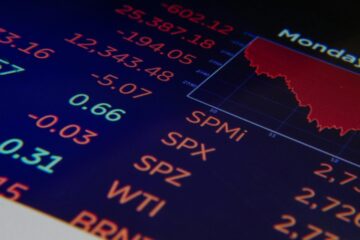Introduction
What is short selling? This is the fundamental question that needs precise defining before we proceed with our article, which unfortunately will not involve Margot Robbie in a bubble bath drinking 20-year-old Dom Pérignon. What it will present however are examples of applications of short selling as part of two strategies – Total Return Swap and Convertible Bond Arb, alternating between the sell-side and buy-side perspectives.
Before we start with the experiential learning process, there might be some marginal benefit in mentioning the “to short sell is to bet against” type definitions. To avoid vagueness, we resort to the following wording defined by the European Commission and the European Securities and Markets Authority (ESMA) in the EU Regulation on Short Selling and certain aspects of credit default swaps that came into force on 1 November 2012.
Short selling is the sale of a security the seller does not own at the time of entering into the agreement with the intention of buying it back at a later point in time in order to deliver it. It can be divided into 2 types: covered short selling (where the seller has made arrangements to borrow the securities before the sale) and naked short selling (where the seller has not borrowed the securities when the short sale occurs).
The two strategies described below naturally are facilitated through the interaction between both the sell-side and the buy-side, however for the benefit of variation of examples we will switch our perspectives between the investment banks and hedge funds to show supply and demand interplay between multiple market participants essential for short selling executions and for different functions that short selling is used for – risk management and speculation.
Sell-Side Perspective on the Total Return Swap
We investigate the execution and unwinding concerns of the Total Return Swap (TRS) from the perspective of a market maker and its pricing. The most common type of total return swap is equity swap where the underlying asset is a stock, a basket of stocks, or a stock index, although the underlying can be almost any asset. Normally one party pays the return based on capital gains and dividends realized on an equity security and the other party pays the return based on a floating interest rate plus a spread. In our setting, the buyer of TRS is the client who wants to gain exposure to the performance, for example of the single stock name and the seller is the market maker. Thus, TRS give clients the opportunity to capture the performance of an asset without owning it. Hedge funds (as clients) use TRS to obtain leverage on the underlying – they can receive the return of the asset without having to put out the cash to buy it and usually post a smaller amount of collateral upfront, thus obtaining leverage. Client is the payer of the leg referred to as the floating leg (the financing leg) which is pegged to a floating rate such as LIBOR. The market maker is the payer of the other leg of the swap referred to as the equity leg that is based on the performance of either a share of individual stock or stock index. Unlike interest rate swaps, the equity swap notional resets on each cash flow reset date, depending on the performance of the underlying asset. In general, a party enters an equity swap with the objective of either obtaining return exposure or hedging existing equity risk for a predetermined period. An equity swap can be used to transfer both the credit risk and the market risk of an underlying asset. Equity swaps can be also used to avoid transaction costs (e.g. tax), to avoid locally based dividend taxes, limitations on leverage (e.g. the US margin regime) or to get around rules on the type of investment an institution can hold.
Focusing on the pricing considerations, given that the market maker is the inherent short side to TRS, he will proceed to hedge his exposure by going long the name in question that he would need to finance through lending the stock and receiving cash that would in turn be delivered to his initial long due payment. The cost of the unwinding just described is the cost passed through the financing leg that the client pays. That unwinding is achieved by repoing out the stock after buying it or through lending the stock out to a short seller counterparty. (Should the client have wanted short TRS, the market maker would have been the long side to the transaction, he would have unwound the unwanted long risk he took on by short selling the stock.)
On the topic of dividends, since the market maker owns the stock, he receives the all-in dividend in the fraction predetermined by the jurisdictions in question. The spread between the fraction of the expected dividends the market maker will receive from his initial long (not always 100% due to regulatory reasons) and how much the client requires is the fraction of the dividend that should be passed through back to the client and thus will be deducted from the financing leg. It is important to highlight the fact that the TRS pricing is performed on the expectation of the dividend (which is the assumption on the future absolute dividend, i.e. one of the main risks the market maker takes on) and the percentage of the dividend that the market maker expects to achieve.
As will be noted below, the short selling ban of the 2008 crisis did not apply to market makers. Their need to risk manage their books, illustrated through pricing an interesting instrument such as TRS, hopefully shows why market makers would be excluded from such restrictions.
Buy-Side Perspective on the Convertible Bond Arb
A convertible bond has an embedded call option that gives bondholders the right to convert their bonds into equity at a given time for a predetermined number of shares in the issuing company. As could be expected, convertible bonds typically have lower yields than the yields on similar fixed rate bonds without the convertible option. Issuers have several reasons to use convertible financing. By issuing convertibles they can lower their cost of debt funding compared to straight debt alone. Lower-credit companies who may not be able to access the straight debt market can often still issue convertible debt. Companies who anticipate equity appreciation can use convertibles to defer equity financing to a time when growth has been achieved.
Investors find several features of convertibles appealing. They offer greater satiability of income than common stock. They provide a yield that is often higher than the dividend yield of common stock. Finally, because they are often theoretically underpriced, they may provide a cheap source of common stock volatility. To the extent that there are mispricings of the equity with the respect to the convertible bond, the investors will arbitrage such opportunities, with the goal of consistently making money regardless of market conditions and to do so with minimal volatility. The basic mechanics of this market neutral approach is to take simultaneous long and short positions in a convertible bond and its underlying stock. By having the appropriate hedge between long and short positions, the arbitrageur hopes to profit whether the market goes up or down. The arbitrageur seeks to exploit mispricings between a convertible bond and its underlying stock. If a convertible is cheap relative to its underlying stock, the arbitrageur will buy the convertible and sell short the underlying shares. He will do the reverse if the convertible bond is overvalued relative to its underlying shares. How much the arbitrageur buys and sells of each security depends upon the appropriate hedge ratio.
This strategy is an example of which market participants create demand for the short-selling services and also how a naked short position (where the seller has not borrowed the securities when the short sale occurs) can be fully delta-hedged through the opposite exposure to another instrument such as a convertible bond. We now see why such strategies would represent downward price pressures on the single names that they trade on and what is the purpose of bans on short-selling activities.
Short sale bans
During global financial crises, regulators tend to implement temporary market stabilizing tools and one of the most frequent ones are the short sale bans imposed on different asset classes. The interpretation to those restrictions is to disincentivize speculation and the self-perpetuating reduction of asset prices. However, this conventional reasoning has its dissenting views in that short selling represents one of the most important mechanisms of bearish expression necessary in all market conditions. To that effect, the power of a short sale ban is limited by the extent to which the investors can circumvent it by entering allowed alternative positions to replicate their desired exposures.
We now look to review the intended and unintended consequences of short sale bans on a case study of the September 2008 short sale restrictions on stocks of fins imposed by the Securities and Exchange Commission (SEC). Hopefully the review will serve to induce this concept, which we will then deduce onto the March 2020 period in the part two of the article.
The Case of Fall 2008
On 19 September 2008, the SEC halted the short selling of financial names. Market-makers that sold short to hedge positions and engage in market-making activity were excluded from the ban. The formally stated purpose of the ban was two-fold.
First intended consequence was to limit the influence of speculation on financial sector stocks. Despite the ban having caused a decrease in the percentage of the float sold short on US listed fins, there is evidence that the percentage of float sold short is similar for the banned and not banned samples of stocks meaning that there was also a collateral reduction in short interest across the market (Harris et al., 2010). Moreover, the short-sale market may provide an incomplete picture of short positions during the ban. As the ban did not extend to market makers in derivatives markets, it was theoretically possible for investors to bypass the ban by purchasing puts or CDS on banned single names. Harris et al. (2010) estimate price inflation at the end of the ban at 12.8% for stocks without traded options, while price inflation effects were negligible for stocks with traded options, i.e. derivs were providing a tool for the price correction. Moreover, as evidenced in Courtney (2010), analysis of the CDS price indices indicates that the CDS spreads of entities covered by the ban rose at a higher rate during the period of the ban than those of entities not covered as could be expected.
Second purpose was to boost the investor confidence amid the market uncertainty. Concept of investor confidence in the short run can be quantified as the change in aggregate market prices surrounding the ban and aggregate market volatility. These two measures serve to dynamically illustrate changes in investor perceptions of financial sector firms’ future cash flows or their riskiness, as well as the level of disagreement in these valuations.
Using a factor analytic model, Harris et al. (2010) report price inflation of 10 to 12% during the ban for banned stocks but there is no clear attribution of price inflation to the ban. This is because simultaneously to the short sale ban, US Congress was debating the Troubled Asset Relief Program (TARP) which was broadly expected by investors to benefit financial sector stocks determining the priced in buy sentiment consensus. Moreover, if there was any causal ban related effect on prices, they should have experienced a downward adjustment following the restrictions, and not any price accretion.
When it comes to the volatility effects of the ban, Lioui (2009) finds that the ban on short selling increased the volatility of stock prices and exacerbated the effects of the original crisis by systemically spreading volatility to the entire market. These results lead Lioui to conclude that the ban on short sales had a greater impact on the overall market than it did on the actual practice of short selling, and that this in turn exaggerated the very problem of market volatility that the ban was designed to solve.
It is based on the above evidence that we can construct a case that bans on short sales appear to have failed to support aggregate market prices and that volatility increased significantly during the ban reflecting an erosion of consensus on asset values and an increase in investor uncertainty.
In fact, the unintended consequences proved to be far more pervasive. To the extent that short selling has positive effects such as informational efficiency, less volatile returns and higher liquidity, the absence of this market tool has impactful consequences.
The most dominant one is the impediment of price discovery amid the lack of liquidity. Assuming spreads to be the best quantifiable proxy for liquidity, Boehmer et al. (2010) found that during the ban the effective spreads on banned names widened from 42 to 145bps relative to a widening of 35 to 57bps for the constructed control. Ni and Pan (2011) examine information flows between the U.S. equity, option, and CDS markets. They find that cross-sectional predictability increases between the equity market and both derivatives markets in relation to negative indicators, implying informational incompleteness of equity markets. Another unintended effect of the ban were the price inflations in the options and CDS markets due to the already elaborated reasoning. These were reflected in the widening of the spreads and in the increase of the transaction costs. Final consequence we mention relates to the near collapse of the convertible bond market which has the clear potential to quickly downward spiral into distressed companies’ capital structure and limit their funding capacity which exacerbates the crisis for the most fragile names. The 2008 short sale ban undoubtedly induced a severe decline of capital supply for convertible bonds and the resulting decline in issuances for all firms.
While we cannot observe what would have happened had there not been a short selling ban imposed, there is an ex-post consensus that these restrictions came at significant costs to the various market participants that this ban was intended to protect. What is certain is that the unprecedented crises serve as case studies for the future implementations of the temporary market stabilizing tools. Unfortunately, this year has brought about another major crisis that caused regulator reactions globally.



0 Comments